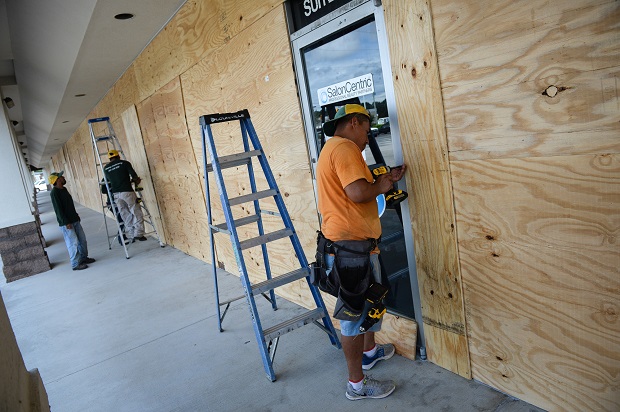 Workers secure plywood to business exteriors ahead of Hurricane Florence in Wilmington, North Carolina. Besides millions of residents affected by winds and flooding, the markets are also anticipating a hit. (Photo: Charles Mostoller/Bloomberg)
Workers secure plywood to business exteriors ahead of Hurricane Florence in Wilmington, North Carolina. Besides millions of residents affected by winds and flooding, the markets are also anticipating a hit. (Photo: Charles Mostoller/Bloomberg)
(Bloomberg) –The punch packed by Hurricane Florence is already rattling markets from stocks to bonds.
The massive storm — which is forcing more than 1 million people to flee and could wreak as much as $27 billion in damages as it cuts a path through the states of Georgia and the Carolinas — has struck insurance companies' shares and funds holding catastrophe bonds as investors try to get ahead of the potential disaster.
“Investor focus appears to be turning more and more to hurricane Florence and the damage and disruption it might create,” UniCredit Bank analyst Erik Nielsen, the firm's global chief economist, wrote in a note.
Here are some of the markets that are most vulnerable to the impending storm:
Stocks
Insurance companies could be on the hook as the storm may cause $15 billion to $20 billion in covered losses from wind and coastal storm surge. Ahead of these possible claims, the sub-index of insurance firms in the S&P 500 has slid for five straight days.
Companies with the biggest exposure to the Southeast U.S. include Allstate Corp., Travelers Companies Inc., Berkshire Hathaway Inc., The Progressive Corp., CNA Financial Corp. and American International Group Inc., according to Wells Fargo Bank.
Another sector that could take a beating are electric and natural gas companies that serve the states in the potential path of destruction. Duke Energy Corp. fell for a fourth day in a row Wednesday, the longest stretch in three months, while SCANA Corp. touched the lowest since June. Broadly, energy producers got a boost as the hurricane threatened to stretch crude supplies.
Banks with large operations in the region facing Florence's trajectory include TowneBank, Carolina Financial Corp., Union Bankshares Crop., United Community Banks Inc., First Bancorp, Synovus Financial Corp. and BB&T Corp., according to Raymond James. Financial firms paced declines on the stock benchmark Wednesday.
Retail companies may also be affected as the storm forces locations in harm's way to shutter. More than 10 percent of Dollar General and Dollar Tree's stores are in states in the path of the storm. But purchases to prepare for the storm “could be partial offsets,” according to Bloomberg Intelligence. As for department stores, Dillard's is the most-exposed with 9 percent of its stores in target states.
Certain restaurants with locations in the region, including Bojangles Inc. and Carrols Restaurant, may also take a hit from Florence. With nearly 60 percent of its store locations in the Carolinas, Bojangles shares have fallen five straight days. The restaurant operator fell 5.5 percent Wednesday, the most since March.
Other industries that could be moved by Hurricane Florence include cement and building materials stocks, auto parts suppliers as well as airlines and hotels due to potential cancellations.
On the flip side, home-improvement retailers are seeing a storm-related boost. Home Depot Inc. and Lowe's Cos. both reached all-time highs this week. Generac Holdings Inc., which makes generators, touched the highest since 2014 after rising more than 8 percent over the previous four days before giving back some of the gain on Wednesday.
Catastrophe bonds
Catastrophe bonds are perhaps the most direct bet on the potential disaster: Insurers issue them to transfer risk of losses related to events like hurricanes to investors.
The Swiss Re Cat Bond Index, a widely-cited gauge for catastrophe bond performance, hasn't moved on the news as it updates only on Fridays. The index suffered a decline of 16 percent last year during hurricane season that took about nine months to recoup. However, the benchmark hasn't had a negative year in data going back 15 years.
But some mutual funds that invest in reinsurance products like catastrophe bonds are already feeling the impact of the storm. The $5.8 billion Stone Ridge Reinsurance Risk Premium Interval Fund fell 5 percent Monday, its biggest one-day decline since last September when Hurricane Irma approached Florida. The fund, which recovered more than half its losses on Tuesday, provides regular payments to investors but can lose money if storm damage costs are too high.
Mortgage-backed securities
The collateral for more than $20 billion worth of commercial loans bundled into securities is located in North Carolina, South Carolina and Virginia, according to Morgan Stanley. Some $8.3 billion worth of property sits within 25 miles of the coastline. The last time a hurricane of this magnitude struck South Carolina, it caused $4.2 billion of insured losses, the bank said.
Consumer and residential mortgages are likely to be impacted by the storm and many homes don't have flood insurance in the potentially affected areas, Raymond James analyst David Long wrote.
Agriculture
North Carolina is the top U.S. producer of tobacco crops. The hurricane threatens to cause plants to rot, causing losses as high as $300 million, according to Matthew Vann, a tobacco specialist at the North Carolina State University in Raleigh.
© 2025 ALM Global, LLC, All Rights Reserved. Request academic re-use from www.copyright.com. All other uses, submit a request to [email protected]. For more information visit Asset & Logo Licensing.







